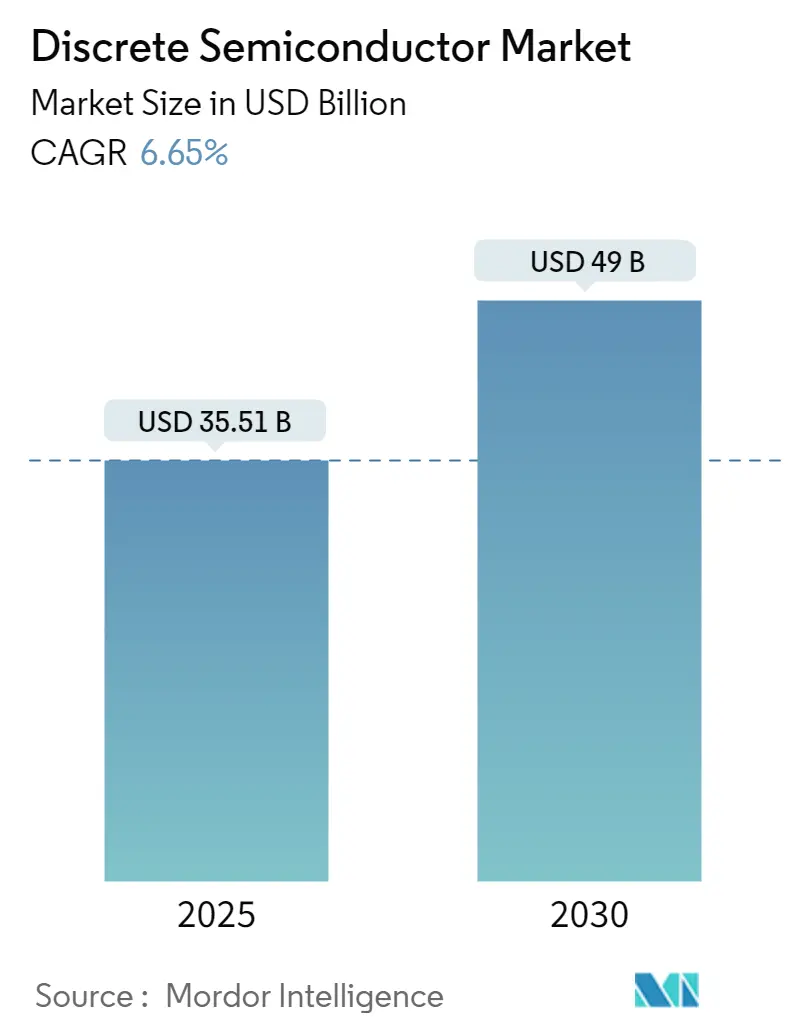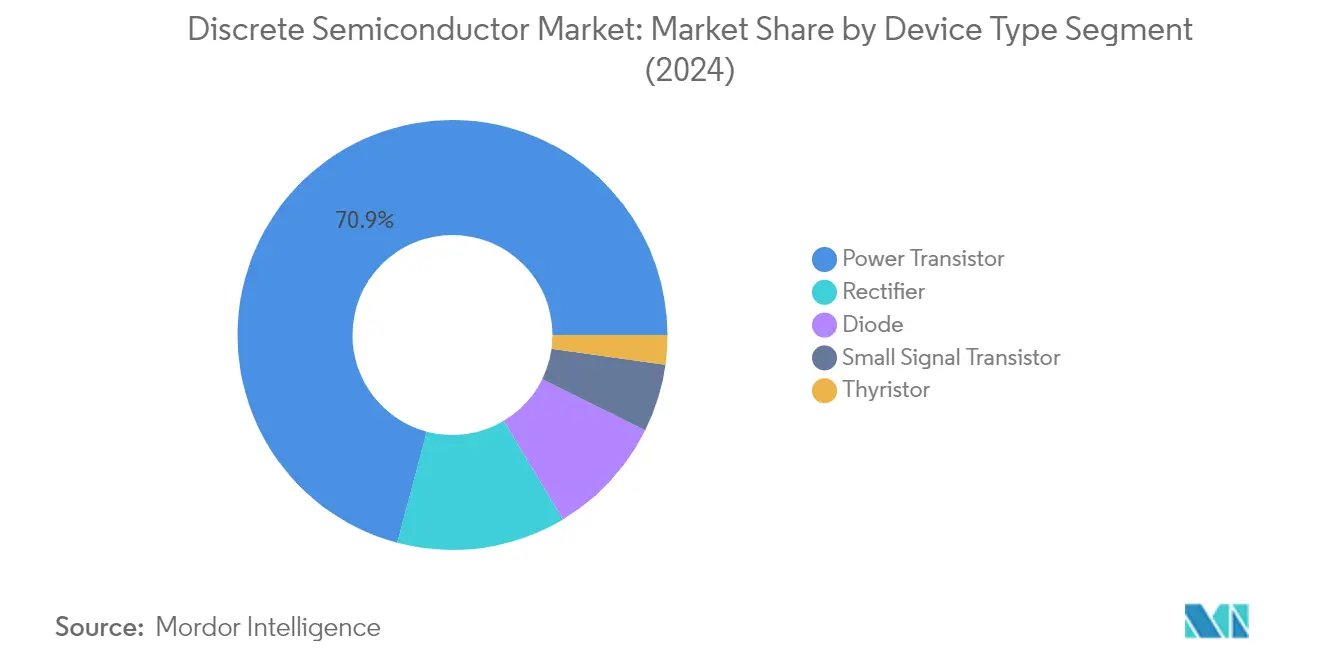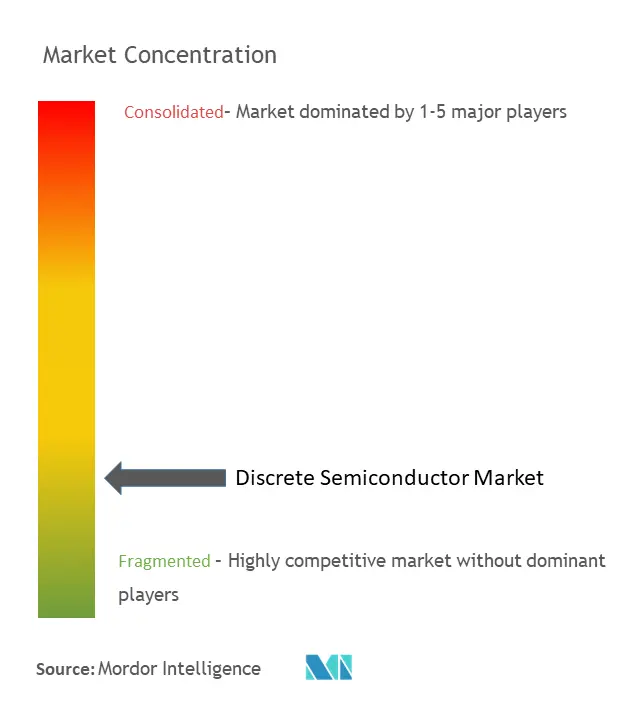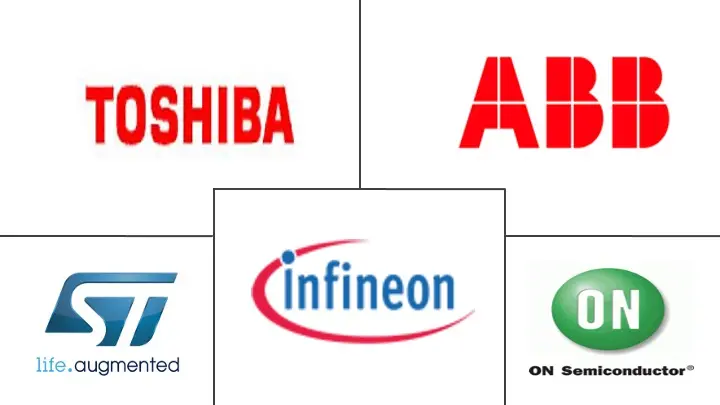
Discrete Semiconductor Market Analysis
The Discrete Semiconductor Market size is estimated at USD 35.51 billion in 2025, and is expected to reach USD 49.00 billion by 2030, at a CAGR of 6.65% during the forecast period (2025-2030). In terms of shipment volume, the market is expected to grow from 427.21 billion units in 2025 to 544.99 billion units by 2030, at a CAGR of 4.99% during the forecast period (2025-2030).
The discrete semiconductor industry is experiencing significant transformation driven by technological advancements in miniaturization, increased power efficiency, and improved performance capabilities. These innovations are creating new possibilities for semiconductor component integration across various devices and systems, particularly in emerging technologies like the Internet of Things (IoT), artificial intelligence (AI), and autonomous vehicles. The industry's evolution is further evidenced by the rapid growth in mobile connectivity, with global smartphone mobile network subscriptions reaching almost seven billion in 2023 and projected to exceed 7.7 billion by 2028, indicating the expanding application base for discrete semiconductors.
Geopolitical tensions and supply chain disruptions continue to reshape the semiconductor industry landscape. The ongoing Russia-Ukraine conflict has led to significant challenges in raw material supply, particularly affecting the availability of neon gas, which is crucial for semiconductor component manufacturing. This situation has prompted manufacturers to diversify their supply chains and move component manufacturing closer to end markets. For instance, Tesla has recently directed its suppliers to relocate portions of their manufacturing operations outside both China and Taiwan to mitigate geopolitical risks.
The industrial sector is witnessing substantial growth in automation and smart manufacturing initiatives, driving demand for power semiconductor solutions in power management and control systems. According to the International Energy Agency (IEA), investments in power grids and energy storage reached nearly USD 370 billion in 2023, highlighting the increasing focus on infrastructure development and industrial modernization. This trend is particularly evident in the adoption of advanced power electronics for industrial automation, smart grids, and energy management systems.
The automotive sector's transformation, particularly in electric vehicle (EV) manufacturing, represents a significant market opportunity for discrete semiconductor manufacturers. This is exemplified by China's robust EV production, which reached 589,000 battery electric vehicles in August 2023, demonstrating the growing demand for power semiconductor technologies in automotive applications. The industry is responding with innovations in silicon carbide (SiC) and gallium nitride (GaN) technologies, which offer superior performance characteristics for high-power applications in electric vehicles, charging infrastructure, and advanced driver assistance systems. Additionally, the integration of transistor and power MOSFET technologies is enhancing the efficiency and performance of these systems.
Discrete Semiconductor Market Trends
Rising Demand for High-Energy and Power-Efficient Devices in the Automotive and Electronics Segment
The automotive industry's transformation towards electrification and autonomous driving technologies has created an unprecedented demand for high-energy and power-efficient discrete semiconductors. These semiconductor components are crucial in enabling sophisticated functionalities like adaptive cruise control, lane-keeping assist, and collision avoidance systems, which require precise real-time data processing and sensor fusion capabilities. The integration of SiC-based inverter prototypes has significantly increased, with applications expanding across onboard electric vehicle chargers, DC/DC converters, and drivetrain inverters. This trend is further evidenced by the International Energy Agency's projection that automotive electrification will eliminate the need for approximately 5 million barrels of oil daily by 2030, highlighting the industry's substantial shift towards electronic components.
The consumer electronics sector has emerged as another significant driver for high-energy and power-efficient discrete semiconductors, particularly in applications requiring sophisticated power management and control systems. Power MOSFETs play a vital role in various consumer electronic applications, including reverse battery protection, power source switching between AC adapters and batteries, and load management for features like backlighting. The increasing integration of smart home technologies, portable devices, and wireless applications has further accelerated the demand for efficient power management solutions. These devices require transistors for voltage regulation, signal amplification, and protection circuits, making them indispensable in modern electronic design.
Increasing Demand for Green Energy Power Generation Drives the Market
The global push towards sustainable energy solutions has significantly boosted the demand for power semiconductors in green energy power generation systems. These components are essential in power conversion and control systems for solar inverters, wind turbine control systems, and energy storage solutions. Discrete semiconductors, particularly power MOSFETs and IGBTs, enable efficient power conversion and management, crucial for maximizing the energy yield from renewable sources. The increasing adoption of solar and wind energy systems, coupled with the growing focus on grid modernization, has created a substantial market for high-performance power semiconductors that can handle the specific requirements of renewable energy applications.
The integration of smart grid technologies and energy storage systems has further amplified the need for advanced transistors. These components play a crucial role in managing power flow, ensuring grid stability, and enabling efficient energy distribution. The development of more efficient and compact transistors has enabled the optimization of power electronics in green energy systems, leading to increased energy conversion efficiency and improved overall system performance. This trend is particularly evident in China's aggressive push towards green energy adoption, where the government's commitment to achieving carbon neutrality by 2060 has led to increased investments in renewable energy infrastructure and the corresponding demand for discrete semiconductor components.
Segment Analysis: By Device Type
Power Transistor Segment in Discrete Semiconductor Market
The power transistor segment dominates the discrete semiconductor market, commanding approximately 71% market share in 2024, with a market value of USD 23.59 billion. This significant market position is primarily driven by the segment's crucial role in various applications, particularly in the automotive and industrial sectors. Power transistors, including MOSFETs and IGBTs, are essential components in electric vehicles, motor drives, power supplies, and renewable energy systems. The segment's dominance is further reinforced by the increasing adoption of electric vehicles globally and the growing demand for energy-efficient power management solutions in industrial applications. Additionally, the segment is experiencing the highest growth rate in the market, with a projected CAGR of around 7% from 2024 to 2029, driven by technological advancements in wide-bandgap semiconductors like silicon carbide (SiC) and gallium nitride (GaN).

Remaining Segments in Device Type Segmentation
The discrete semiconductor market encompasses several other significant segments, including rectifiers, diodes, small signal transistors, and thyristors. Rectifiers represent the second-largest segment, playing a vital role in power conversion applications across various industries. Diodes contribute significantly to the market, finding applications in protection circuits, power supplies, and signal processing. Small signal transistors are crucial in low-power applications and signal amplification, particularly in consumer electronics and communication devices. Thyristors, while representing a smaller portion of the market, remain essential in high-power switching applications and industrial control systems. Each of these segments serves specific technological needs and contributes to the overall growth and development of the discrete semiconductor industry.
Segment Analysis: By End-User Vertical
Consumer Electronics Segment in Discrete Semiconductor Market
The consumer electronics segment dominates the discrete semiconductor market, commanding approximately 31% market share in 2024, with a market value of USD 10.27 billion. This significant market position is driven by the widespread integration of discrete semiconductors in various consumer electronic devices, from smartphones and laptops to home appliances and wearable technology. The segment's dominance is further reinforced by the increasing adoption of smart home devices, the growing demand for high-performance computing devices, and the continuous innovation in consumer electronics requiring advanced power management solutions. Discrete semiconductors play a crucial role in these devices by enabling efficient power conversion, voltage regulation, and circuit protection, making them indispensable components in modern consumer electronics.
Automotive Segment in Discrete Semiconductor Market
The automotive segment is emerging as the fastest-growing sector in the discrete semiconductor market, projected to grow at approximately 8% CAGR from 2024 to 2029. This remarkable growth is primarily driven by the accelerating transition towards electric vehicles (EVs) and hybrid vehicles, which require significantly more discrete semiconductor components compared to traditional vehicles. The increasing integration of advanced driver assistance systems (ADAS), sophisticated power management systems, and vehicle electrification initiatives are fueling this growth. Additionally, the automotive industry's focus on developing more energy-efficient vehicles and the rising demand for electric powertrains are creating substantial opportunities for discrete semiconductor manufacturers, particularly in applications such as power conversion, motor control, and battery management systems.
Remaining Segments in End-User Vertical
The industrial, communication, and other end-user verticals collectively represent significant portions of the discrete semiconductor market, each serving unique application needs. The industrial segment is particularly notable for its use of discrete semiconductors in automation, power supplies, and motor drives, while the communication segment focuses on network infrastructure and telecommunications equipment. Other end-user verticals, including aerospace and defense and smart infrastructure, contribute to market diversity through specialized applications requiring high-reliability discrete semiconductors. These segments are experiencing steady growth driven by Industry 4.0 initiatives, 5G network deployment, and increasing automation across various sectors.
Discrete Semiconductor Market Geography Segment Analysis
Discrete Semiconductor Market in China
China dominates the global discrete semiconductor landscape, commanding approximately 36% of the market share in 2024 while demonstrating remarkable growth potential with a projected CAGR of nearly 8% from 2024 to 2029. The country's prominence in the market is reinforced by its position as a global manufacturing powerhouse, particularly in consumer electronics and automotive sectors. China's robust industrial automation sector, with its robotics industry generating over 170 billion yuan in revenue, continues to drive demand for discrete semiconductors. The nation's commitment to technological advancement is evident in its aggressive 5G implementation, with approximately 3.22 million 5G base stations representing 28.1% of all cellular base stations. The government's active promotion of industrial automation and the rapid adoption of smart manufacturing principles under various industrial initiatives further catalyze market growth. Additionally, China's strong focus on electric vehicle production and the presence of major manufacturers like BYD and other domestic players contribute significantly to the sustained demand for semiconductor components.

Discrete Semiconductor Market in Europe
Europe maintains its position as a crucial hub for discrete semiconductor innovation and production, particularly driven by countries like Germany, France, and the United Kingdom. The region's strength lies in its robust automotive sector, which continues to undergo a significant transformation toward electrification. The European Union's aggressive carbon emission reduction targets and the push for electric vehicle adoption create substantial opportunities for power semiconductor applications. The presence of major semiconductor companies and vendors, including ABB Ltd, Infineon Technologies AG, and STMicroelectronics NV, contributes to the region's technological advancement. Europe's commitment to Industry 4.0 principles and the increasing adoption of automation and robotics in manufacturing processes further drive market growth. The region's data center infrastructure expansion, with Germany leading with 522 data centers, demonstrates the growing demand for discrete semiconductors in communication infrastructure. The European semiconductor ecosystem is further strengthened by government initiatives and investments in research and development, particularly in emerging technologies like artificial intelligence and cloud computing.
Discrete Semiconductor Market in United States
The United States continues to be a pivotal player in the discrete semiconductor market, leveraging its strong technological infrastructure and innovation capabilities. The country's market is primarily driven by its large automotive industry and the presence of major semiconductor manufacturers. The nation's commitment to revitalizing domestic semiconductor manufacturing capabilities, exemplified by initiatives like the CHIPS for America Act, demonstrates its dedication to maintaining technological leadership. The country's robust research and development ecosystem, supported by prominent vendors such as ON Semiconductor Corporation, Diodes Incorporated, and Vishay Intertechnology, fosters continuous innovation in discrete semiconductor technology. The increasing adoption of electric vehicles, with companies like Lucid Motors expanding their manufacturing capabilities, further drives market growth. The United States' strong focus on defense and aerospace applications, coupled with significant investments in data centers and cloud computing infrastructure, creates sustained demand for semiconductor components across various applications.
Discrete Semiconductor Market in Taiwan
Taiwan has established itself as a significant player in the discrete semiconductor market, leveraging its advanced manufacturing capabilities and technological expertise. The country's semiconductor ecosystem benefits from substantial government support, including initiatives to accelerate investment in semiconductor manufacturing processes. Taiwan's strength lies in its comprehensive approach to semiconductor development, encompassing research, manufacturing, and testing capabilities. The country's defense sector plays a crucial role in driving demand for power semiconductors, with applications ranging from power drive controls to avionics and communications systems. Taiwan's commitment to developing new semiconductor technologies is evident through various government funding programs and talent recruitment initiatives. The presence of advanced manufacturing facilities and the government's focus on improving the semiconductor ecosystem position Taiwan favorably in the global market. Additionally, the country's emphasis on energy-efficient and high-performance semiconductor products aligns well with global trends toward sustainable and efficient electronic solutions.
Discrete Semiconductor Market in Other Countries
The discrete semiconductor market extends beyond the major players to encompass various other significant regions, each contributing uniquely to the global landscape. Japan, with its strong foundation in electronics manufacturing and technological innovation, continues to play a vital role in the market's development. South Korea leverages its advanced communication technology infrastructure and strong automotive sector to maintain its market presence. Countries in the Asia-Pacific region, including Malaysia, Singapore, and India, are emerging as important players, particularly in the manufacturing and consumption of discrete semiconductors. Latin American countries, particularly Mexico and Brazil, are showing increasing potential in the market, driven by their growing automotive manufacturing sectors. The Middle East and African regions are also witnessing growth in discrete semiconductor adoption, particularly in industrial and communication applications. These diverse markets collectively contribute to the global discrete semiconductor ecosystem, each bringing unique strengths and opportunities for market development.
Discrete Semiconductor Industry Overview
Top Companies in Discrete Semiconductor Market
The discrete semiconductor market features prominent players like ABB, Infineon Technologies, STMicroelectronics, Toshiba, NXP Semiconductors, and ON Semiconductor leading the innovation landscape. These companies are actively advancing their product portfolios through continuous research and development, particularly in silicon carbide (SiC) and gallium nitride (GaN) technologies for power semiconductor devices. Strategic moves in the industry are characterized by vertical integration efforts, with manufacturers expanding their in-house production capabilities while maintaining strategic partnerships with foundries. Companies are increasingly focusing on automotive and industrial applications, developing specialized products for electric vehicles and automation systems. The market witnesses regular product launches in MOSFET and IGBT categories, with emphasis on improved power density, efficiency, and thermal performance. Operational agility is demonstrated through geographic expansion of manufacturing facilities, particularly in Asia, and the development of application-specific solutions for emerging technologies like 5G infrastructure and renewable energy systems.
Consolidated Market with Strong Regional Players
The discrete semiconductor market exhibits a fragmented structure with a mix of global conglomerates and specialized manufacturers competing across different product segments. Large multinational corporations dominate the high-end market segments, leveraging their extensive research capabilities and established relationships with tier-1 customers in automotive and industrial sectors. Regional players, particularly in Asia, maintain strong positions in their local markets through cost-competitive offerings and close customer relationships. The market demonstrates moderate consolidation, with larger players acquiring specialized technology companies to enhance their product portfolios and gain access to emerging technologies.
The competitive dynamics are shaped by the presence of integrated device manufacturers (IDMs) who control the entire value chain from design to manufacturing, alongside fabless companies focusing on design and innovation. Merger and acquisition activities are primarily driven by the need to acquire specialized technologies, particularly in wide bandgap semiconductors and advanced packaging solutions. Companies are increasingly establishing strategic partnerships with automotive OEMs and industrial equipment manufacturers to secure long-term supply agreements and collaborate on product development, reflecting the growing importance of application-specific solutions.
Innovation and Customization Drive Market Success
Success in the power semiconductor market increasingly depends on companies' ability to develop innovative solutions that address specific application requirements while maintaining cost competitiveness. Incumbent players are strengthening their market positions through investments in advanced manufacturing capabilities, particularly for next-generation power discrete devices, while expanding their design and application support services to enhance customer relationships. The ability to offer comprehensive solutions that combine hardware with software and system-level expertise is becoming crucial for maintaining competitive advantage. Companies are also focusing on developing sustainable manufacturing practices and environmentally friendly products to align with global environmental regulations and customer preferences.
For contenders looking to gain market share, specialization in niche applications and development of innovative technologies present viable strategies. The market shows moderate end-user concentration in automotive and industrial sectors, necessitating strong relationships with key customers and the ability to meet stringent quality requirements. Regulatory requirements, particularly regarding environmental impact and energy efficiency, are becoming increasingly important factors in product development and market access. The risk of substitution remains moderate, primarily limited by the essential nature of discrete electronic components in power management applications and the significant technological barriers to developing alternative solutions.
Discrete Semiconductor Market Leaders
-
ABB Ltd
-
ON Semiconductor Corporation
-
Infineon Technologies AG
-
STMicroelectronics NV
-
Toshiba Corporation
- *Disclaimer: Major Players sorted in no particular order

Discrete Semiconductor Market News
- June 2024: Onsemi's proposed investment of up to USD 2 billion over multiple years aims to bolster the advanced power semiconductor supply chain for its European and global clientele. The company is set to build a cutting-edge, vertically integrated silicon carbide (SiC) manufacturing plant in the Czech Republic. This facility is expected to focus on crafting Onsemi's pivotal intelligent power semiconductors, which are crucial for enhancing energy efficiency in electric vehicles, renewable energy systems, and AI data centers.
- May 2024: Infineon Technologies expanded its SiC MOSFET development to encompass voltages below 650 V. The company introduced its latest offering, the CoolSiCMOSFET 400 V family, built on the second-generation (G2) technology, which debuted earlier this year. This new MOSFET lineup is designed for the AC/DC stage of AI servers, aligning with Infineon's recent PSU roadmap. Beyond server applications, these devices find a niche in inverter motor control, solar and energy storage systems, SMPS, and even solid-state circuit breakers in residential settings.
Discrete Semiconductor Market Report - Table of Contents
1. INTRODUCTION
- 1.1 Study Assumptions and Market Definition
- 1.2 Scope of the Study
2. RESEARCH METHODOLOGY
3. EXECUTIVE SUMMARY
4. MARKET INSIGHTS
- 4.1 Market Overview
-
4.2 Industry Attractiveness - Porter's Five Forces Analysis
- 4.2.1 Bargaining Power of Suppliers
- 4.2.2 Bargaining Power of Buyers
- 4.2.3 Threat of New Entrants
- 4.2.4 Threat of Substitute Products
- 4.2.5 Intensity of Competitive Rivalry
- 4.3 Industry Value Chain / Supply Chain Analysis
- 4.4 Impact of COVID-19 Aftereffects and Other Macroeconomic Factors on the Market
5. MARKET DYNAMICS
-
5.1 Market Drivers
- 5.1.1 Rising Demand for High-energy and Power-efficient Devices in the Automotive and Electronics Segment
- 5.1.2 Increasing Demand for Green Energy Power Generation Drives the Market
-
5.2 Market Restraints
- 5.2.1 Rising Demand for Integrated Circuits
6. MARKET SEGMENTATION
-
6.1 By Device Type
- 6.1.1 Diode
- 6.1.2 Small Signal Transistor
- 6.1.3 Power Transistor
- 6.1.3.1 MOSFET Power Transistor
- 6.1.3.2 IGBT Power Transistor
- 6.1.3.3 Other Power Transistor
- 6.1.4 Rectifier
- 6.1.5 Thyristor
-
6.2 By End-user Vertical
- 6.2.1 Automotive
- 6.2.2 Consumer Electronics
- 6.2.3 Communication
- 6.2.4 Industrial
- 6.2.5 Other End-user Verticals
-
6.3 By Geography***
- 6.3.1 United States
- 6.3.2 Europe
- 6.3.3 Japan
- 6.3.4 China
- 6.3.5 South Korea
- 6.3.6 Taiwan
7. COMPETITIVE LANDSCAPE
-
7.1 Company Profiles*
- 7.1.1 ABB Ltd
- 7.1.2 On Semiconductor Corporation
- 7.1.3 Infineon Technologies AG
- 7.1.4 STMicroelectronics NV
- 7.1.5 Toshiba Electronic Devices and Storage Corporation
- 7.1.6 NXP Semiconductors NV
- 7.1.7 Diodes Incorporated
- 7.1.8 Nexperia BV
- 7.1.9 Semikron Danfoss Holding A/S (Danfoss A/S)
- 7.1.10 Eaton Corporation PLC
- 7.1.11 Hitachi Energy Ltd (Hitachi Ltd)
- 7.1.12 Mitsubishi Electric Corporation
- 7.1.13 Fuji Electric Co Ltd
- 7.1.14 Analog Devices Inc.
- 7.1.15 Vishay Intertechnology Inc.
- 7.1.16 Renesas Electronics Corporation
- 7.1.17 Rohm Co. Ltd
- 7.1.18 Microchip Technology
- 7.1.19 Qorvo Inc.
- 7.1.20 Wolfspeed Inc.
- 7.1.21 Texas Instrument Inc.
- 7.1.22 Littelfuse Inc
- 7.1.23 WeEn Semiconductors
8. INVESTMENT ANALYSIS
9. MARKET OPPORTUNITIES AND FUTURE TRENDS
Discrete Semiconductor Industry Segmentation
A discrete semiconductor is a single semiconductor device that performs a basic electronic function. The market is defined by the revenue generated from sales of various types of discrete semiconductors, such as diodes, small signal transistors, power transistors, and rectifiers, employed across multiple end-user verticals, such as automotive, consumer electronics, communication, industrial, and others, across several countries like the United States, Europe, Japan, China, Korea, Taiwan, and the rest of the world.
The discrete semiconductor market is segmented by device type (diode, small signal transistor, power transistor [MOSFET power transistor, IGBT power transistor, and other power transistors], rectifiers, and thyristors), by end-user vertical (automotive, consumer electronics, communication, industrial, and other end-user verticals), and by geography (United States, Europe, Japan, China, South Korea, Taiwan, and rest of the world). The report offers market forecasts and size in volume (shipment units) and value (USD) for all the above segments.
| By Device Type | Diode | ||
| Small Signal Transistor | |||
| Power Transistor | MOSFET Power Transistor | ||
| IGBT Power Transistor | |||
| Other Power Transistor | |||
| Rectifier | |||
| Thyristor | |||
| By End-user Vertical | Automotive | ||
| Consumer Electronics | |||
| Communication | |||
| Industrial | |||
| Other End-user Verticals | |||
| By Geography*** | United States | ||
| Europe | |||
| Japan | |||
| China | |||
| South Korea | |||
| Taiwan | |||
Discrete Semiconductor Market Research FAQs
How big is the Discrete Semiconductor Market?
The Discrete Semiconductor Market size is expected to reach USD 35.51 billion in 2025 and grow at a CAGR of 6.65% to reach USD 49.00 billion by 2030.
What is the current Discrete Semiconductor Market size?
In 2025, the Discrete Semiconductor Market size is expected to reach USD 35.51 billion.
Who are the key players in Discrete Semiconductor Market?
ABB Ltd, ON Semiconductor Corporation, Infineon Technologies AG, STMicroelectronics NV and Toshiba Corporation are the major companies operating in the Discrete Semiconductor Market.
Which is the fastest growing region in Discrete Semiconductor Market?
Asia Pacific is estimated to grow at the highest CAGR over the forecast period (2025-2030).
Which region has the biggest share in Discrete Semiconductor Market?
In 2025, the Asia Pacific accounts for the largest market share in Discrete Semiconductor Market.
What years does this Discrete Semiconductor Market cover, and what was the market size in 2024?
In 2024, the Discrete Semiconductor Market size was estimated at USD 33.15 billion. The report covers the Discrete Semiconductor Market historical market size for years: 2019, 2020, 2021, 2022, 2023 and 2024. The report also forecasts the Discrete Semiconductor Market size for years: 2025, 2026, 2027, 2028, 2029 and 2030.
Our Best Selling Reports
Discrete Semiconductor Market Research
Mordor Intelligence provides a comprehensive analysis of the discrete semiconductor market. We leverage decades of expertise in semiconductor component research. Our extensive coverage includes key technologies such as transistors, diodes, rectifiers, and thyristors. This offers detailed insights into the evolving landscape of power semiconductor technologies. The report thoroughly examines discrete electronic components and power discrete devices. It pays particular attention to advanced technologies like bipolar transistors and power MOSFETs.
Stakeholders in the transistor industry and power semiconductor industry benefit from our detailed analysis of discrete power devices and emerging technologies. The report is available as an easy-to-download PDF. It offers valuable insights into developments in the diode market, thyristor market, and power MOSFET market. Our research methodology ensures comprehensive coverage of the transistor market and the broader power semiconductor market. This enables businesses to make informed decisions based on reliable data and expert analysis of the discrete semiconductor ecosystem.



